2021 CHEVROLET COLORADO light
[x] Cancel search: lightPage 45 of 89

Chevrolet/GMC 2.8L Duramax Diesel Engine Supplement (GMNA-Localizing-
U.S./Canada-14465442) - 2021 - CRC - 2/3/20
44 Driving and Operating
remain at curb idle. A press and release
of +RES on the cruise control will restore
engine rpm to the last PTO set speed. The
PTO system can also be programmed to
return engine rpm to the PTO Standby
Speed setting.
.Press*on the cruise control. The engine
returns to base idle, but the PTO load
relay remains engaged. The PTO indicator
light will blink slowly indicating that a
PTO set speed is still stored in memory.
Activating +RES on the cruise control will
restore engine rpm to the last PTO set
speed.
.Press and release the PTO in-cab switch.
The PTO load relay disengages and the
engine returns to base idle. The PTO
indicator light will turn off, indicating the
PTO load relay is disengaged and the
stored set speed has been cleared from
memory.
Stationary Modes (Preset or Variable) –
Remote Control
To disengage PTO:
.Open the Remote PTO Engine Start/
Shutdown switch. Load relay disengages
and the engine will stop.
.If equipped, press the PTO Emergency
Stop switch. Load relay disengages and
the engine will stop. Refer to the bulletins
in the GM Upfitter Integration website
www.gmupfitter.com for the Power
Take-Off (PTO) operating description and
application guide.
.With the key in the ignition and rotated
to the RUN position, press the brake
pedal. The PTO load relay disengages and
the engine returns to base idle speed. The
operator may drive the vehicle.
Stationary Modes will also disengage if:
.Vehicle movement is detected.
.The parking brake is released.
.The transmission is shifted out of
P (Park).
.The ignition is cycled from RUN to OFF.
.The PTO feedback signal is lost indicating
the load is disengaged if used. See
www.gmupfitter.com.
.Cruise control becomes enabled.
.Timed auto-engine shutdown: This feature
will shut down the engine automatically
after a predefined time. PTO must be
operational for this function to be active.
.Engine shutdown based on critical engine
or PTO system fault conditions: This
feature will shut down the engine when
PTO is operating if a critical engine
condition such as low oil, low oil pressure,
hot engine, hot transmission, low fuel,
or Diesel Particulate Filter regeneration is
detected by the vehicle system. If PTO
operation is continued when critical
engine conditions are present, a horn
chirp warning will occur after 30–
60 seconds. The engine will shut down
two minutes after the horn warning. The
engine can be restarted with the ignition
key or with the Remote PTO engine start
controls. The horn warning and engine
shutdown will again occur if the critical
engine condition is still present.
Resume memory speed is cleared for the
above actions.
When Remote PTO engine starting has been
initialized with the ignition key in the RUN
position, the shift lever will remain locked if
the brake pedal is pressed and a shift from
P (Park) is attempted while the engine is
running and PTO is active (standby mode).
A shift out of P (Park) will not be allowed
until one of the following actions is taken
by the vehicle operator:
Page 46 of 89
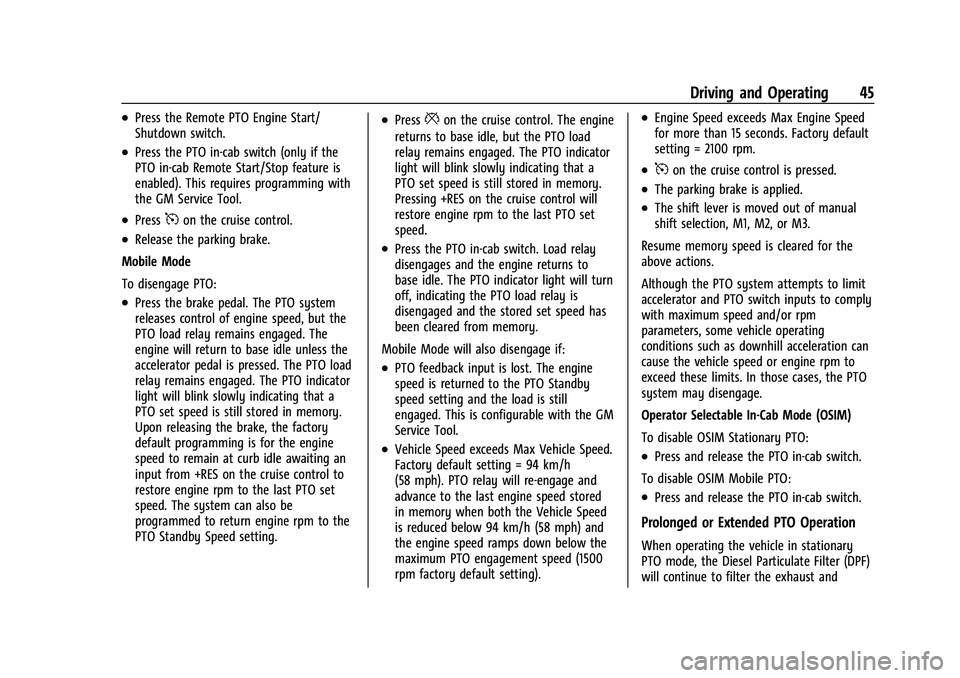
Chevrolet/GMC 2.8L Duramax Diesel Engine Supplement (GMNA-Localizing-
U.S./Canada-14465442) - 2021 - CRC - 2/3/20
Driving and Operating 45
.Press the Remote PTO Engine Start/
Shutdown switch.
.Press the PTO in-cab switch (only if the
PTO in-cab Remote Start/Stop feature is
enabled). This requires programming with
the GM Service Tool.
.Press5on the cruise control.
.Release the parking brake.
Mobile Mode
To disengage PTO:
.Press the brake pedal. The PTO system
releases control of engine speed, but the
PTO load relay remains engaged. The
engine will return to base idle unless the
accelerator pedal is pressed. The PTO load
relay remains engaged. The PTO indicator
light will blink slowly indicating that a
PTO set speed is still stored in memory.
Upon releasing the brake, the factory
default programming is for the engine
speed to remain at curb idle awaiting an
input from +RES on the cruise control to
restore engine rpm to the last PTO set
speed. The system can also be
programmed to return engine rpm to the
PTO Standby Speed setting.
.Press*on the cruise control. The engine
returns to base idle, but the PTO load
relay remains engaged. The PTO indicator
light will blink slowly indicating that a
PTO set speed is still stored in memory.
Pressing +RES on the cruise control will
restore engine rpm to the last PTO set
speed.
.Press the PTO in-cab switch. Load relay
disengages and the engine returns to
base idle. The PTO indicator light will turn
off, indicating the PTO load relay is
disengaged and the stored set speed has
been cleared from memory.
Mobile Mode will also disengage if:
.PTO feedback input is lost. The engine
speed is returned to the PTO Standby
speed setting and the load is still
engaged. This is configurable with the GM
Service Tool.
.Vehicle Speed exceeds Max Vehicle Speed.
Factory default setting = 94 km/h
(58 mph). PTO relay will re-engage and
advance to the last engine speed stored
in memory when both the Vehicle Speed
is reduced below 94 km/h (58 mph) and
the engine speed ramps down below the
maximum PTO engagement speed (1500
rpm factory default setting).
.Engine Speed exceeds Max Engine Speed
for more than 15 seconds. Factory default
setting = 2100 rpm.
.5on the cruise control is pressed.
.The parking brake is applied.
.The shift lever is moved out of manual
shift selection, M1, M2, or M3.
Resume memory speed is cleared for the
above actions.
Although the PTO system attempts to limit
accelerator and PTO switch inputs to comply
with maximum speed and/or rpm
parameters, some vehicle operating
conditions such as downhill acceleration can
cause the vehicle speed or engine rpm to
exceed these limits. In those cases, the PTO
system may disengage.
Operator Selectable In-Cab Mode (OSIM)
To disable OSIM Stationary PTO:
.Press and release the PTO in-cab switch.
To disable OSIM Mobile PTO:
.Press and release the PTO in-cab switch.
Prolonged or Extended PTO Operation
When operating the vehicle in stationary
PTO mode, the Diesel Particulate Filter (DPF)
will continue to filter the exhaust and
Page 47 of 89
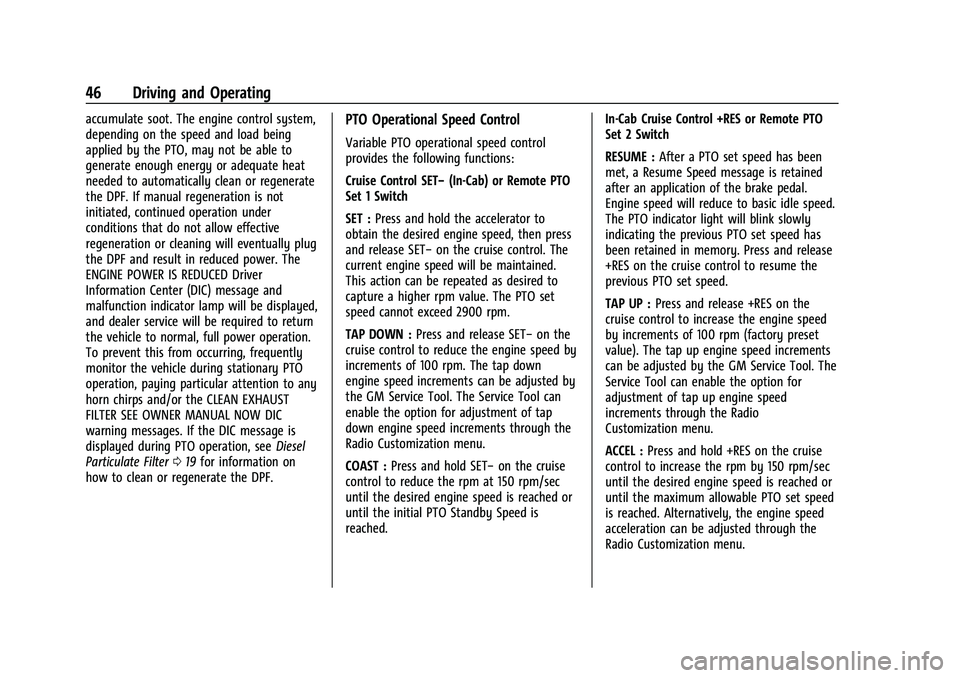
Chevrolet/GMC 2.8L Duramax Diesel Engine Supplement (GMNA-Localizing-
U.S./Canada-14465442) - 2021 - CRC - 2/3/20
46 Driving and Operating
accumulate soot. The engine control system,
depending on the speed and load being
applied by the PTO, may not be able to
generate enough energy or adequate heat
needed to automatically clean or regenerate
the DPF. If manual regeneration is not
initiated, continued operation under
conditions that do not allow effective
regeneration or cleaning will eventually plug
the DPF and result in reduced power. The
ENGINE POWER IS REDUCED Driver
Information Center (DIC) message and
malfunction indicator lamp will be displayed,
and dealer service will be required to return
the vehicle to normal, full power operation.
To prevent this from occurring, frequently
monitor the vehicle during stationary PTO
operation, paying particular attention to any
horn chirps and/or the CLEAN EXHAUST
FILTER SEE OWNER MANUAL NOW DIC
warning messages. If the DIC message is
displayed during PTO operation, seeDiesel
Particulate Filter 019 for information on
how to clean or regenerate the DPF.PTO Operational Speed Control
Variable PTO operational speed control
provides the following functions:
Cruise Control SET− (In-Cab) or Remote PTO
Set 1 Switch
SET : Press and hold the accelerator to
obtain the desired engine speed, then press
and release SET− on the cruise control. The
current engine speed will be maintained.
This action can be repeated as desired to
capture a higher rpm value. The PTO set
speed cannot exceed 2900 rpm.
TAP DOWN : Press and release SET− on the
cruise control to reduce the engine speed by
increments of 100 rpm. The tap down
engine speed increments can be adjusted by
the GM Service Tool. The Service Tool can
enable the option for adjustment of tap
down engine speed increments through the
Radio Customization menu.
COAST : Press and hold SET− on the cruise
control to reduce the rpm at 150 rpm/sec
until the desired engine speed is reached or
until the initial PTO Standby Speed is
reached. In-Cab Cruise Control +RES or Remote PTO
Set 2 Switch
RESUME :
After a PTO set speed has been
met, a Resume Speed message is retained
after an application of the brake pedal.
Engine speed will reduce to basic idle speed.
The PTO indicator light will blink slowly
indicating the previous PTO set speed has
been retained in memory. Press and release
+RES on the cruise control to resume the
previous PTO set speed.
TAP UP : Press and release +RES on the
cruise control to increase the engine speed
by increments of 100 rpm (factory preset
value). The tap up engine speed increments
can be adjusted by the GM Service Tool. The
Service Tool can enable the option for
adjustment of tap up engine speed
increments through the Radio
Customization menu.
ACCEL : Press and hold +RES on the cruise
control to increase the rpm by 150 rpm/sec
until the desired engine speed is reached or
until the maximum allowable PTO set speed
is reached. Alternatively, the engine speed
acceleration can be adjusted through the
Radio Customization menu.
Page 51 of 89
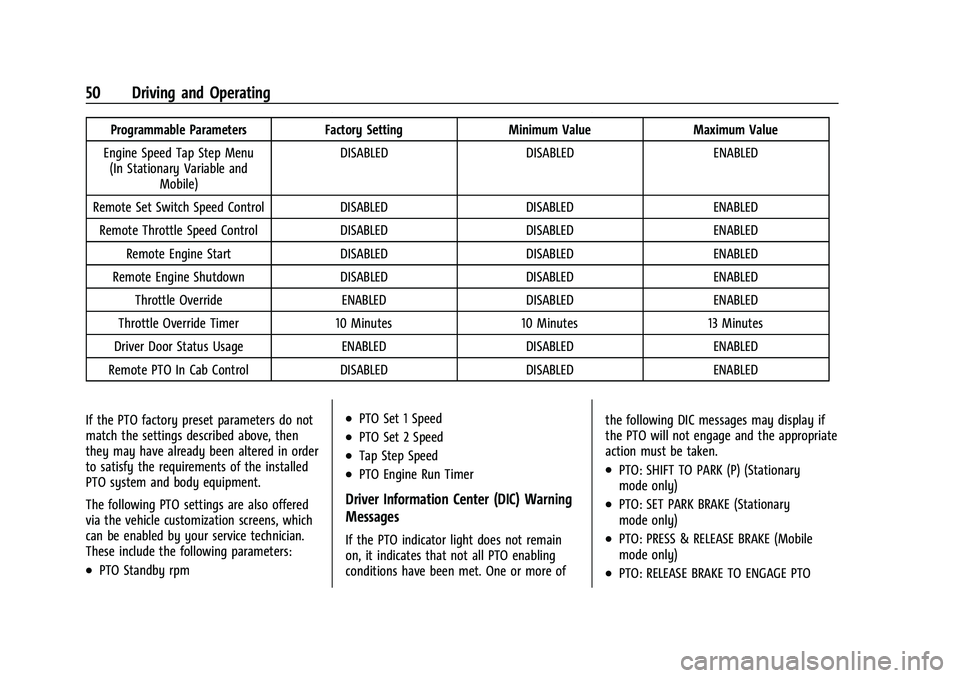
Chevrolet/GMC 2.8L Duramax Diesel Engine Supplement (GMNA-Localizing-
U.S./Canada-14465442) - 2021 - CRC - 2/3/20
50 Driving and Operating
Programmable ParametersFactory SettingMinimum Value Maximum Value
Engine Speed Tap Step Menu (In Stationary Variable and Mobile) DISABLED
DISABLED ENABLED
Remote Set Switch Speed Control DISABLEDDISABLED ENABLED
Remote Throttle Speed Control DISABLEDDISABLED ENABLED
Remote Engine Start DISABLEDDISABLED ENABLED
Remote Engine Shutdown DISABLEDDISABLED ENABLED
Throttle Override ENABLEDDISABLED ENABLED
Throttle Override Timer 10 Minutes10 Minutes 13 Minutes
Driver Door Status Usage ENABLEDDISABLED ENABLED
Remote PTO In Cab Control DISABLEDDISABLED ENABLED
If the PTO factory preset parameters do not
match the settings described above, then
they may have already been altered in order
to satisfy the requirements of the installed
PTO system and body equipment.
The following PTO settings are also offered
via the vehicle customization screens, which
can be enabled by your service technician.
These include the following parameters:
.PTO Standby rpm
.PTO Set 1 Speed
.PTO Set 2 Speed
.Tap Step Speed
.PTO Engine Run Timer
Driver Information Center (DIC) Warning
Messages
If the PTO indicator light does not remain
on, it indicates that not all PTO enabling
conditions have been met. One or more of the following DIC messages may display if
the PTO will not engage and the appropriate
action must be taken.
.PTO: SHIFT TO PARK (P) (Stationary
mode only)
.PTO: SET PARK BRAKE (Stationary
mode only)
.PTO: PRESS & RELEASE BRAKE (Mobile
mode only)
.PTO: RELEASE BRAKE TO ENGAGE PTO
Page 52 of 89
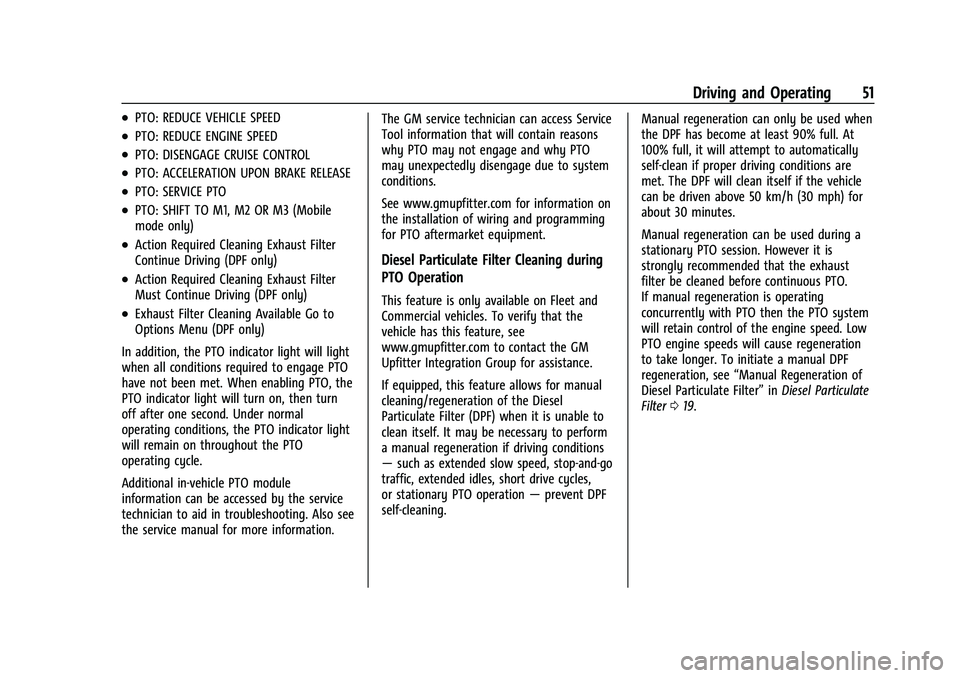
Chevrolet/GMC 2.8L Duramax Diesel Engine Supplement (GMNA-Localizing-
U.S./Canada-14465442) - 2021 - CRC - 2/3/20
Driving and Operating 51
.PTO: REDUCE VEHICLE SPEED
.PTO: REDUCE ENGINE SPEED
.PTO: DISENGAGE CRUISE CONTROL
.PTO: ACCELERATION UPON BRAKE RELEASE
.PTO: SERVICE PTO
.PTO: SHIFT TO M1, M2 OR M3 (Mobile
mode only)
.Action Required Cleaning Exhaust Filter
Continue Driving (DPF only)
.Action Required Cleaning Exhaust Filter
Must Continue Driving (DPF only)
.Exhaust Filter Cleaning Available Go to
Options Menu (DPF only)
In addition, the PTO indicator light will light
when all conditions required to engage PTO
have not been met. When enabling PTO, the
PTO indicator light will turn on, then turn
off after one second. Under normal
operating conditions, the PTO indicator light
will remain on throughout the PTO
operating cycle.
Additional in-vehicle PTO module
information can be accessed by the service
technician to aid in troubleshooting. Also see
the service manual for more information. The GM service technician can access Service
Tool information that will contain reasons
why PTO may not engage and why PTO
may unexpectedly disengage due to system
conditions.
See www.gmupfitter.com for information on
the installation of wiring and programming
for PTO aftermarket equipment.
Diesel Particulate Filter Cleaning during
PTO Operation
This feature is only available on Fleet and
Commercial vehicles. To verify that the
vehicle has this feature, see
www.gmupfitter.com to contact the GM
Upfitter Integration Group for assistance.
If equipped, this feature allows for manual
cleaning/regeneration of the Diesel
Particulate Filter (DPF) when it is unable to
clean itself. It may be necessary to perform
a manual regeneration if driving conditions
—
such as extended slow speed, stop-and-go
traffic, extended idles, short drive cycles,
or stationary PTO operation —prevent DPF
self-cleaning. Manual regeneration can only be used when
the DPF has become at least 90% full. At
100% full, it will attempt to automatically
self-clean if proper driving conditions are
met. The DPF will clean itself if the vehicle
can be driven above 50 km/h (30 mph) for
about 30 minutes.
Manual regeneration can be used during a
stationary PTO session. However it is
strongly recommended that the exhaust
filter be cleaned before continuous PTO.
If manual regeneration is operating
concurrently with PTO then the PTO system
will retain control of the engine speed. Low
PTO engine speeds will cause regeneration
to take longer. To initiate a manual DPF
regeneration, see
“Manual Regeneration of
Diesel Particulate Filter” inDiesel Particulate
Filter 019.
Page 60 of 89

Chevrolet/GMC 2.8L Duramax Diesel Engine Supplement (GMNA-Localizing-
U.S./Canada-14465442) - 2021 - CRC - 2/3/20
Vehicle Care 59
How to Inspect/Replace the Engine Air
Cleaner/Filter
Do not start the engine or have the engine
running with the engine air filter housing
open. Before removing the engine air filter,
make sure that the engine air filter housing
and nearby components are free of dirt and
debris. Remove the engine air filter. Lightly
tap and shake the engine air filter (away
from the vehicle) to release dust and dirt.
Inspect the engine air filter for damage, and
replace if damaged. Do not clean the engine
air filter or components with water or
compressed air.
1. Screws
2. Retaining Clips3. Housing Base
4. Housing Cover
5. Turbo Air Duct
To inspect and replace the filter:
1. Remove the two screws (1) and lift the air cleaner/filter housing base (3) to clear
the turbo air duct (5).
2. Unlock the two retaining clips (2) on the sides of the housing cover (4) and on the
housing base and pull the cover off.
3. Remove the air cleaner/filter from the housing base. Take care to dislodge as
little dirt as possible.
4. Clean the air cleaner/filter sealing surface and housing base.
5. Install the engine air cleaner/filter by aligning the arrow on one side of the air
cleaner/filter end cap with the arrow on
top of the housing base.
6. Reinstall the housing cover by aligning the arrow on top of the cover to the
arrow on top of the housing base, and
fasten the two retaining clips.
7. Align the two bushings under the housing base to the guide pins below on
the closure assembly and push the
housing base into place. 8. Reinstall the two screws to secure the
housing base.{Warning
If part replacement is necessary, the part
must be replaced with one of the same
part number or with an equivalent part.
Use of a replacement part without the
same fit, form, and function may result
in personal injury or damage to the
vehicle.
See Maintenance Schedule 073 or
Maintenance Schedule 077 to determine
when to replace the engine air cleaner/filter.
{Warning
Operating the engine with the air
cleaner/filter off can cause you or others
to be burned. Use caution when working
on the engine. Do not start the engine or
drive the vehicle with the air cleaner/
filter off, as flames may be present if the
engine backfires.
Page 61 of 89

Chevrolet/GMC 2.8L Duramax Diesel Engine Supplement (GMNA-Localizing-
U.S./Canada-14465442) - 2021 - CRC - 2/3/20
60 Vehicle Care
Caution
If the air cleaner/filter is off, dirt can
easily get into the engine, which could
damage it. Always have the air cleaner/
filter in place when driving.
Cooling System
The cooling system allows the engine to
maintain the correct working temperature.
2.8L 4-Cylinder Engine Pickup Models
See“Cooling System” in the owner’s
manual.
2.8L 4-Cylinder Engine Van Models
1. Coolant Surge Tank
2. Coolant Surge Tank Pressure Cap
3. Engine Cooling Fan (Out of View)
{Warning
An underhood electric fan can start up
even when the engine is not running and
can cause injury. Keep hands, clothing,
and tools away from any underhood
electric fan.
{Warning
Do not touch heater or radiator hoses,
or other engine parts. They can be very
hot and can burn you. Do not run the
engine if there is a leak; all coolant could
leak out. That could cause an engine fire
and can burn you. Fix any leak before
driving the vehicle.
Engine Coolant
The cooling system in the vehicle is
filled with DEX-COOL engine coolant
mixture. See Recommended Fluids and
Lubricants 078 and
Maintenance Schedule 073 or
Maintenance Schedule 077. The following explains the cooling system
and how to add coolant when it is low.
If there is a problem with engine
overheating, see
Engine Overheating 062.
A 50/50 mixture of clean, drinkable water
and DEX-COOL coolant will:
.Give freezing protection down to −37 °C
(−34 °F).
.Give boiling protection up to 129 °C
(265 °F).
.Protect against rust and corrosion.
.Help keep the proper engine temperature.
.Let the warning lights and gauges work
as they should.
What to Use
{Warning
Plain water, or other liquids such as
alcohol, can boil before the proper
coolant mixture will. With plain water or
the wrong mixture, the engine could get
too hot but there would not be an
overheat warning. The engine could catch
fire and you or others could be burned.
Page 67 of 89
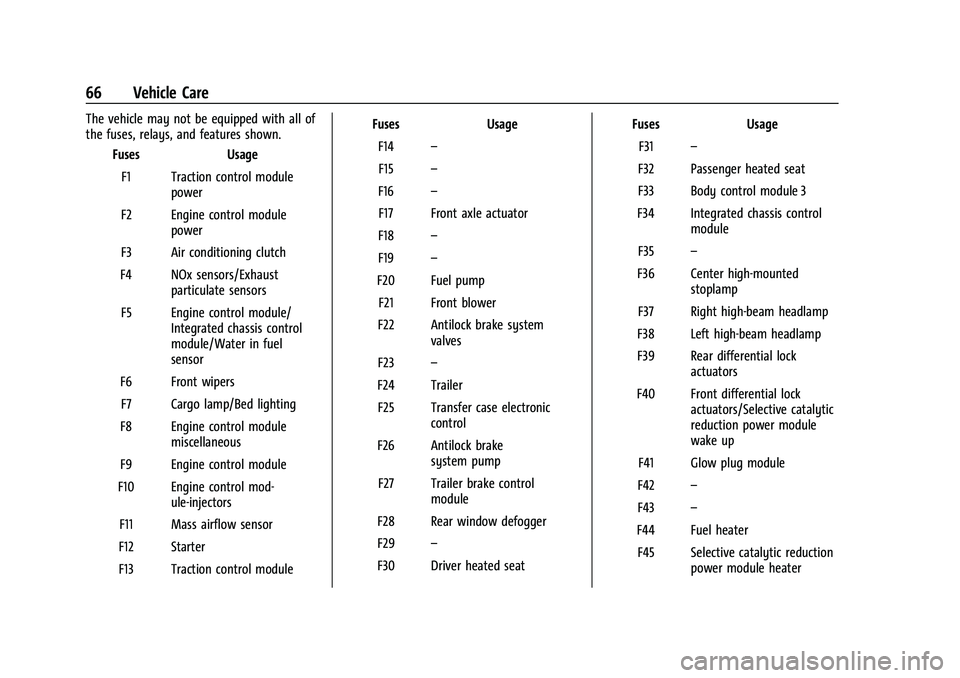
Chevrolet/GMC 2.8L Duramax Diesel Engine Supplement (GMNA-Localizing-
U.S./Canada-14465442) - 2021 - CRC - 2/3/20
66 Vehicle Care
The vehicle may not be equipped with all of
the fuses, relays, and features shown.Fuses Usage
F1 Traction control module power
F2 Engine control module power
F3 Air conditioning clutch
F4 NOx sensors/Exhaust particulate sensors
F5 Engine control module/ Integrated chassis control
module/Water in fuel
sensor
F6 Front wipers F7 Cargo lamp/Bed lighting
F8 Engine control module miscellaneous
F9 Engine control module
F10 Engine control mod- ule-injectors
F11 Mass airflow sensor
F12 Starter
F13 Traction control module Fuses
Usage
F14 –
F15 –
F16 –
F17 Front axle actuator
F18 –
F19 –
F20 Fuel pump F21 Front blower
F22 Antilock brake system valves
F23 –
F24 Trailer F25 Transfer case electronic control
F26 Antilock brake system pump
F27 Trailer brake control module
F28 Rear window defogger
F29 –
F30 Driver heated seat Fuses
Usage
F31 –
F32 Passenger heated seat
F33 Body control module 3
F34 Integrated chassis control module
F35 –
F36 Center high-mounted stoplamp
F37 Right high-beam headlamp
F38 Left high-beam headlamp
F39 Rear differential lock actuators
F40 Front differential lock actuators/Selective catalytic
reduction power module
wake up
F41 Glow plug module
F42 –
F43 –
F44 Fuel heater F45 Selective catalytic reduction power module heater